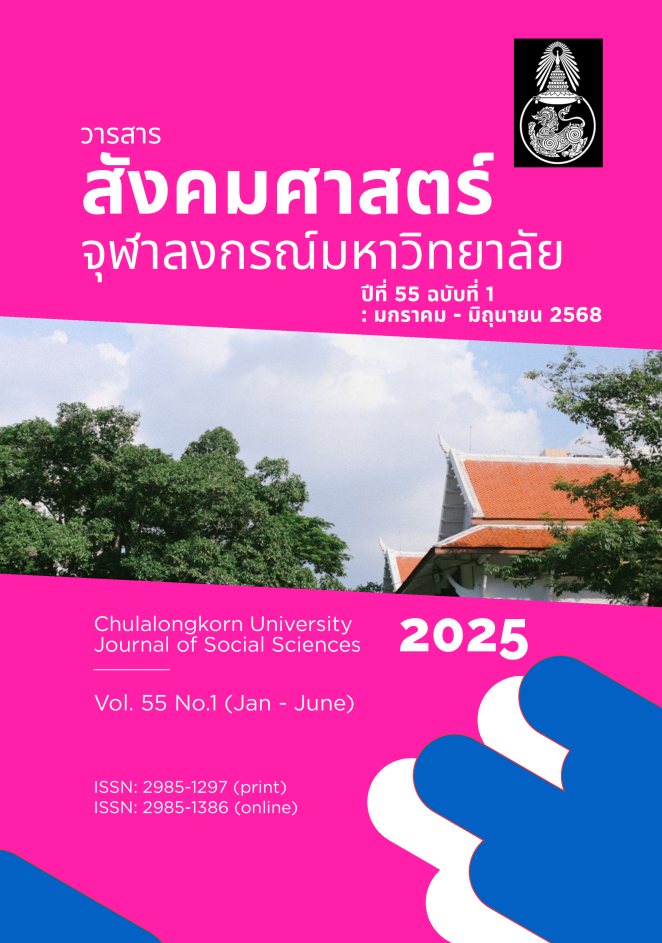Fiscal Multiplier of Economic Stimulation Measures of Thailand
DOI:
https://doi.org/10.61462/cujss.v55i1.3810Keywords:
Fiscal Multiplier, Discretionary Fiscal Policy, Economic Stabilization PolicyAbstract
This study estimates the fiscal multiplier using a widely accepted econometric procedure at present, applying five different datasets to reflect government spending. The estimates of government spending multipliers in this study are at 0.25-0.49, which are lower than 1. This indicates the ineffectiveness of economic stimulation measures in Thailand, a small open economy, equipped with a large informal sector. The resulting government spending multipliers are estimated based on the government's budget disbursement data, which does not cover disbursements for the principal repayment of debt and expenditures for the replenishment of the treasury account balance/reserve fund. This dataset is more consistent with the government's implementation of economic stabilization measures than the dataset used in previous studies.
Downloads
References
Barro, Robert J. 1974. "Are Government Bonds Net Wealth?" Journal of Political Economy 82 (6): 1095–1117. https://doi.org/10.1086/260266.
Barro, Robert J. 1989. "The Ricardian Approach to Budget Deficits." The Journal of Economic Perspectives 3 (2): 37–54. https://doi.org/10.1257/jep.3.2.37.
Blanchard, Olivier, and Roberto Perotti. 2002. "An Empirical Characterization of the Dynamic Effects of Changes in Government Spending and Taxes on Output." Quarterly Journal of Economics 117: 1329–1368. https://doi.org/10.1162/003355302320935043.
Cardoso, Dante, Henrique Carvalho, Davide Lima, Gabriel Pires, Renato Rugitsky, and Daniel Sanches. 2023. "The Multiplier Effects of Government Expenditures on Social Protection: A Multi-Country Analysis." Working Paper Series No. 2023-11, Department of Economics, FEA-USP. http://www.repec.eae.fea.usp.br/documentos/Cardoso_Carvalho_Lima_Pires_Rugitsky_Sanches_11WP.pdf.
Cornevin, Antoine, Juan S. Corrales, and Juan Pablo Angel. 2023. "A Deep Dive into Tax Buoyancy: Comparing Estimation Techniques in a Large Heterogeneous Panel." IMF Working Paper WP/23/71, International Monetary Fund. https://doi.org/10.5089/9798400238376.001.
Ljungqvist, Lars. 2008. "Lucas Critique." In The New Palgrave Dictionary of Economics, 2nd ed., edited by Steven N. Durlauf and Lawrence E. Blume. New York: Palgrave Macmillan. https://doi.org/10.1057/978-1-349-95121-5_2784-1.
Lucas, Robert E., Jr. 1976. "Econometric Policy Evaluation: A Critique." Carnegie-Rochester Conference Series on Public Policy 1 (1): 19–46. https://doi.org/10.1016/S0167-2231(76)80003-6.
Mineshima, Aiko, Marcos Poplawski-Ribeiro, and Anke Weber. 2014. "Size of Fiscal Multipliers." In Post-Crisis Fiscal Policy, edited by Carlo Cottarelli, Philip Gerson, and Abdelhak Senhadji, 315–-72. Cambridge: MIT Press. https://doi.org/10.7551/mitpress/9780262027182.003.0018.
Natthikan Vorasa-ngasil. 2008. "Indicators of Stimulus and Fiscal Multipliers in Thailand." Bank of Thailand.
Narongchai Thitinanphong. 2021. "A Guide to Analyzing the Impact of Government Spending on GDP through Fiscal Multipliers." Budget Office of the Parliament, Secretariat of the House of Representatives. https://dl.parliament.go.th/handle/20.500.13072/599346.
Ouliaris, Sam, Adrian Pagan, and Jorge Restrepo. 2018. "Quantitative Macroeconomic Modeling with Structural Vector Autoregressions: An EViews Implementation." Mimeo. https://www.eviews.com/StructVAR/structvar.html.
Perotti, Roberto, Ricardo Reis, and Valerie Ramey. 2007. “In Search of the Transmission Mechanism of Fiscal Policy [with Comments and Discussion].” NBER Macroeconomics Annual 22 (January):169–249. https://doi.org/10.1086/ma.22.25554966.
Pfaff, Bernhard. 2008. "VAR, SVAR and SVEC Models: Implementation within R Package vars." Journal of Statistical Software 27 (4): 1–32. https://doi.org/10.18637/jss.v027.i04.
Puapan, Pisit. 2011. "The Fiscal Policy Impact on Economic Performance in ASEAN5+3: Empirical Analyses." PhD diss., School of Development Economics, National Institute of Development Administration (NIDA). http://tic.car.chula.ac.th/th/ageing-society/102-ascc4/23649-the-fiscal-policy-impact-on-economic-performance-in-asean5-3-empirical-analyses.
Downloads
Published
How to Cite
Issue
Section
License
Copyright (c) 2025 Faculty of Political Science, Chulalongkorn University

This work is licensed under a Creative Commons Attribution-NonCommercial-NoDerivatives 4.0 International License.
Public Licensing Terms
Copyright and Licensing Policy
The Chulalongkorn University Journal of Social Science publishes all content under the Creative Commons Attribution-NonCommercial-NoDerivatives 4.0 International License (CC BY-NC-ND 4.0).
Copyright
All published articles in the Chulalongkorn University Journal of Social Science are the copyright of the Faculty of Political Science, Chulalongkorn University. Authors transfer all rights to the journal upon acceptance of their manuscript for publication.
CC BY-NC-ND 4.0 License
Under this license:
-
Attribution (BY): Users must give appropriate credit to the authors, the Faculty of Political Science, Chulalongkorn University, and the Chulalongkorn University Journal of Social Science, provide a link to the license, and indicate if changes were made. They may do so in any reasonable manner, but not in any way that suggests the licensor endorses them or their use.
-
NonCommercial (NC): Users may not use the material for commercial purposes. Commercial use requires prior written permission from both the authors and the Faculty of Political Science, Chulalongkorn University.
-
NoDerivatives (ND): If users remix, transform, or build upon the material, they may not distribute the modified material. Adaptations of the work require prior written permission from both the authors and the Faculty of Political Science, Chulalongkorn University.
Open Access Statement
The Chulalongkorn University Journal of Social Science provides immediate open access to its content on the principle that making research freely available to the public supports a greater global exchange of knowledge. Users are allowed to read, download, copy, distribute, print, search, or link to the full texts of the articles without asking prior permission from the publisher or the author, in accordance with the CC BY-NC-ND 4.0 license.
Self-Archiving Policy
Authors may archive the final published version, preprints, or postprints of their articles in institutional repositories or on their personal websites, provided that they acknowledge the original publication in the Chulalongkorn University Journal of Social Science with a complete citation and a link to the journal's website.
Permissions
For any use beyond those covered by the CC BY-NC-ND 4.0 license, please contact:
Editorial Office
Chulalongkorn University Journal of Social Science
Faculty of Political Science, Chulalongkorn University
Email: cusocscij@gmail.com
For more information about the Creative Commons Attribution-NonCommercial-NoDerivatives 4.0 International License, please visit: https://creativecommons.org/licenses/by-nc-nd/4.0/




